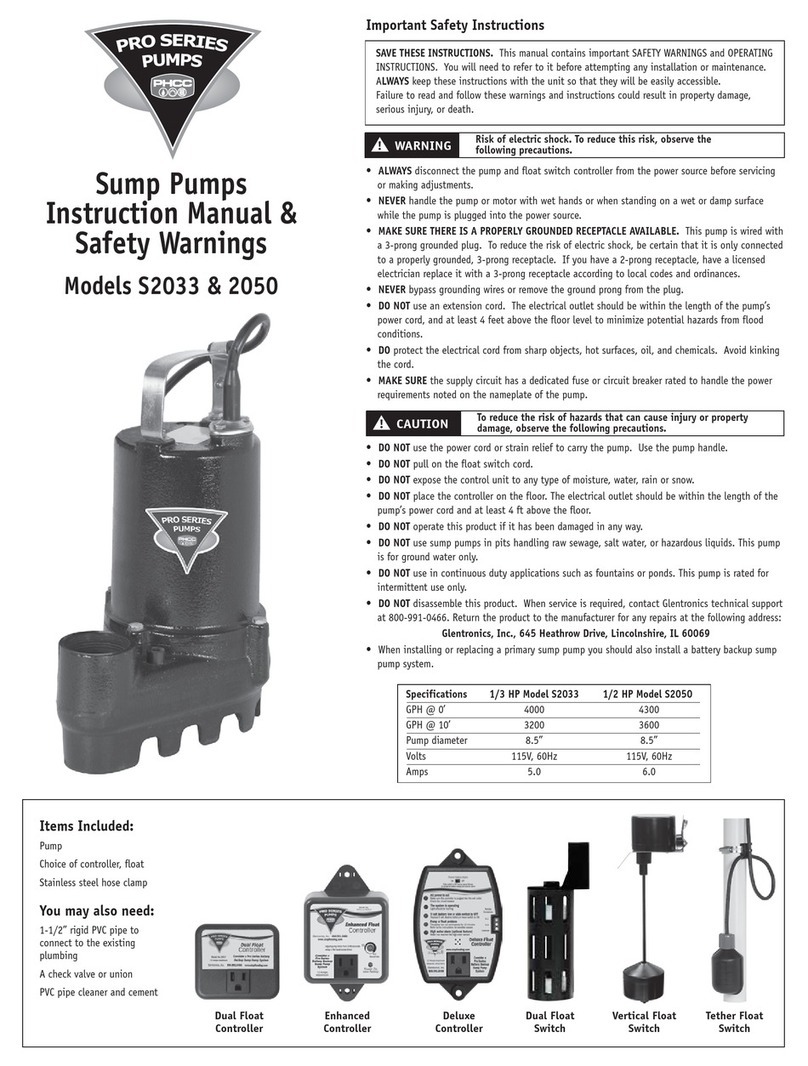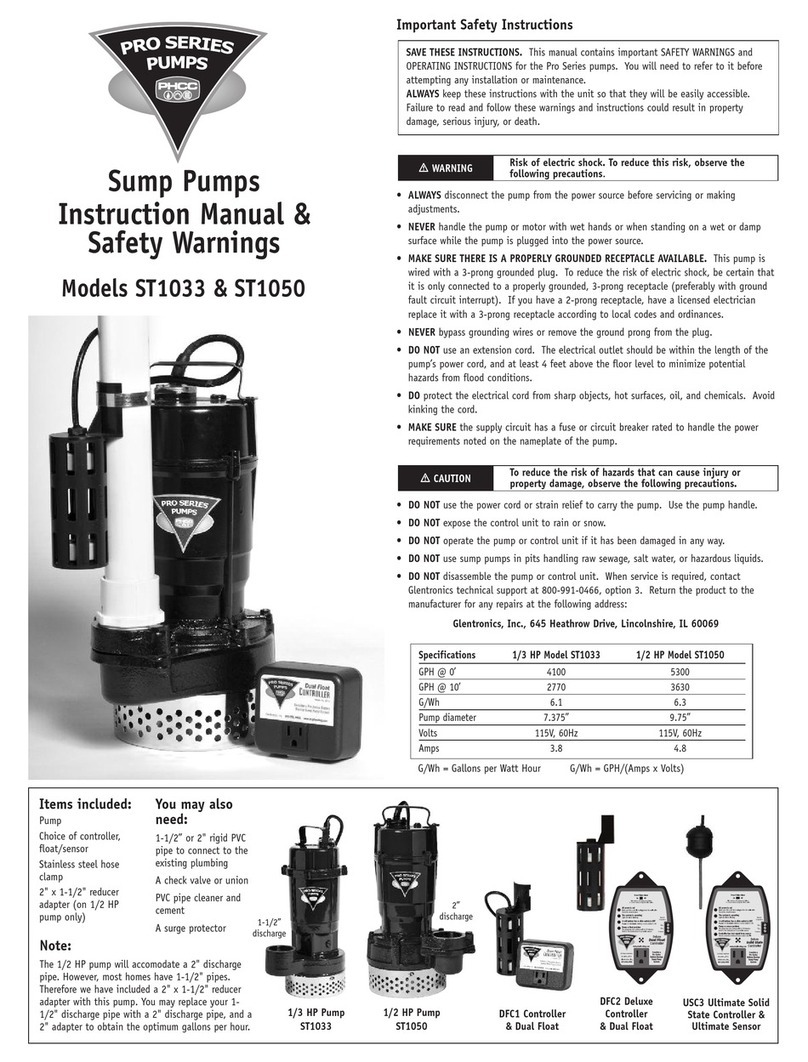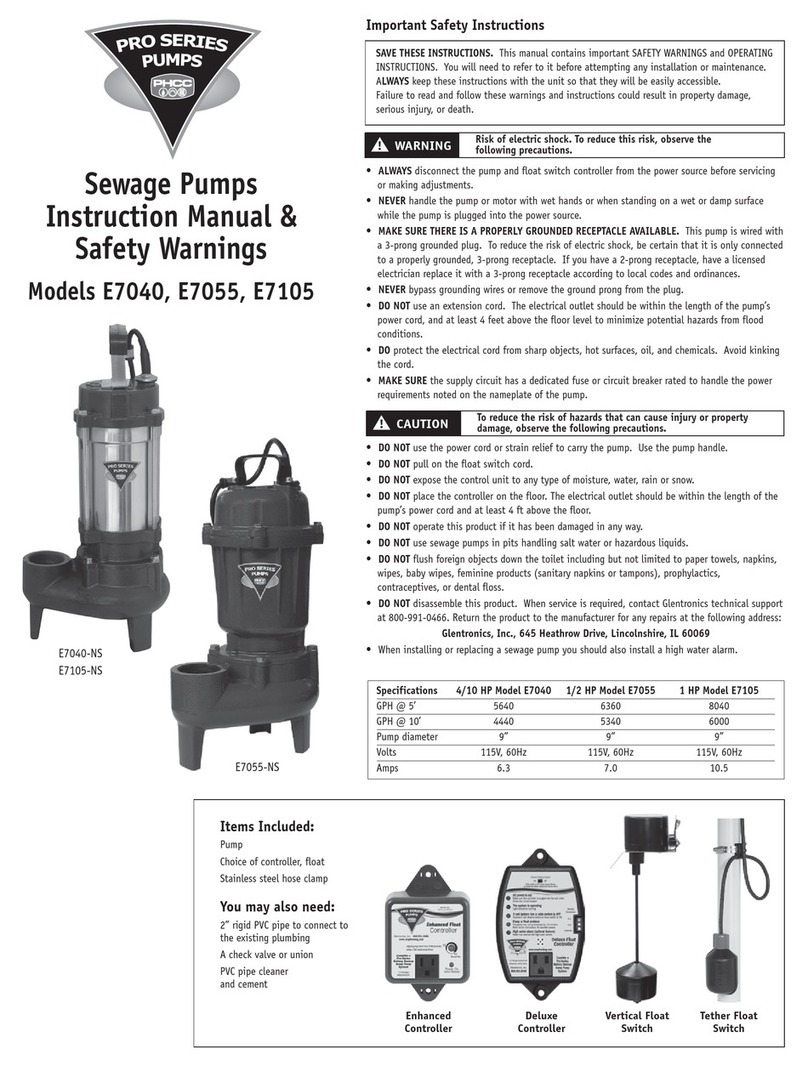Important Safety
Warnings & Instructions
SAVE THESE INSTRUCTIONS. This manual
contains important SAFETY WARNINGS and
OPERATING INSTRUCTIONS for the Pro Series
battery backup sump pump system. You will
need to refer to it before attempting any
installation or maintenance. ALWAYS keep these
instructions with the unit so that they will be
easily accessible.
Failure to read and follow these warnings and
instructions could result in property damage,
serious injury, or death. It is important to read
this manual, even if you did not install the Pro
Series backup sump pump, since this manual
contains safety information regarding the use
and maintenance of this product. DO NOT
DISCARD THIS MANUAL.
ELECTRICAL PRECAUTIONS
Risk of electrical and fire hazard. May result
in death, serious injury, shock or burns.
To help reduce these risks, observe the
following precautions:
• DO NOT walk on wet areas of the basement
until all power has been turned off. If the
main power supply is in a wet basement, call
an electrician.
• NEVER handle the control unit with wet hands
or while standing on a wet surface.
• ALWAYS unplug the control unit and dis-
connect the cables from the battery before
attempting any maintenance or cleaning.
• ALWAYS unplug the main pump when instal-
ling or servicing the backup pump to avoid
electric shock.
• DO NOT expose the control unit to rain or
snow.
• Pull the plug rather than the cord when
disconnecting the control unit.
• An extension cord should not be used unless
absolutely necessary. If an extension cord
must be used, be sure the plug has the same
configuration as the plug on the control unit.
• Use of an attachment not recommended or
sold by the manufacturer may result in a risk
of fire or injury from an electrical shock.
• DO NOT operate the computer control unit if it
has received a sharp blow, been dropped, or
otherwise damaged in any way. Contact
Glentronics technical support at 800-991-
0466, option #3.
• DO NOT disassemble the control unit. When
service is required, contact Glentronics tech-
nical support at 800-991-0466, option #3.
Return the control unit to the manufacturer for
any repairs at the following address:
Glentronics, Inc.
640 Heathrow Drive
Lincolnshire, IL 60069
BATTERY PREPARATION
Sulfuric acid can cause blindness or severe
burns. Avoid contact with skin, eyes or
clothing. In the event of accident, flush
with water and call a physician immediately.
KEEP OUT OF REACH OF CHILDREN.
To help reduce these risks, observe the
following precautions:
• Someone should be within range of your voice
or close enough to come to your aid when you
work near a lead-acid battery.
• Have plenty of fresh water and soap nearby in
case battery acid contacts skin, clothing or
eyes.
• Wear eye and clothing protection and avoid
touching your eyes while working with battery
acid or working near the battery.
• If battery acid contacts skin or clothing, wash
immediately with soap and water. If acid
enters eye, immediately flood eye with run-
ning cold water for at least 10 minutes and get
medical attention.
• Battery posts and terminals contain lead and
lead compounds, chemicals known to the State
of California to cause cancer and reproductive
harm. Wash hands after handling.
BATTERY PRECAUTIONS
Explosive gases could cause serious injury
or death. Cigarettes, flames or sparks could
cause battery to explode in enclosed spaces.
Charge in well-ventilated area. Always
shield eyes and face from battery. Keep
vent caps tight and level.
To help reduce these risks, observe the
following precautions:
• NEVER smoke or allow a spark or flame in the
vicinity of the battery.
• Use the Pro Series control unit for charging a
LEAD-ACID battery only. Do not use the
control unit for charging dry-cell batteries that
are most commonly used with home
appliances.
• Be sure the area around the battery is well
ventilated.
• When cleaning or adding water to the battery,
first fan the top of the battery with a piece of
cardboard or another non-metallicmaterial to
blow away any hydrogen or oxygen gas that
may have been emitted from the battery.
• DO NOT drop a metal tool onto the battery. It
might spark or short-circuit the battery and
cause an explosion.
• Remove personal metal items such as rings,
bracelets, watches, etc. when working with a
lead-acid battery. A short circuit through one
of these items can melt it causing a severe
burn.
• ALWAYS remove the power cord from the
electrical outlet before connecting or
disconnecting the battery cables. Never allow
the rings to touch each other.
• Check the polarity of the battery posts. The
POSITIVE (+) battery post usually has a larger
diameter than the NEGATIVE (-) post.
• When connecting the battery cables, first
connect the small ring on the end of the
WHITE wire to the NEGATIVE (-) post of the
battery, and then connect the large ring on
end of the BLACK wire to the POSITIVE (+) post
of the battery.
Do not use system to pump flammable or
explosive fluids such as gasoline, fuel oil,
kerosene, etc.
Page 1
!DANGER
!DANGER
!WARNING / POISON
!DANGER
POSITIVE POST HAS
LARGER DIAMETER NEGATIVE POST HAS
SMALLER DIAMETER
POSITIVE
POST NEGATIVE
POST






























